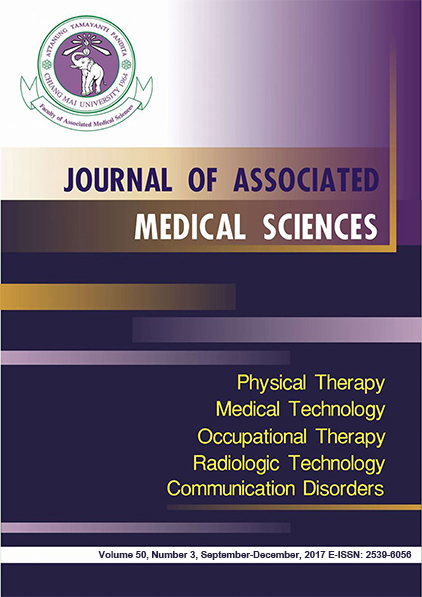Functional Abilities of Stroke Survivors who Received Services at Community Rehabilitation Center
Main Article Content
Abstract
Background: Numbers of people with disabilities resulting from stroke are increasing in Thailand. Major sequela following a disease is weakness in one side of body which causes difficulty in functional abilities to those survivors. Community-based rehabilitation can be one of the potential strategies that enhance functional performance in individuals with disabilities.
Objectives: Purpose of the present study was to investigate functional abilities of stroke survivors who received services provided by trained village health volunteers (VHVs) for a period of 3 months at their own community rehabilitation center.
Materials and methods: This study was a one group pretest-posttest research design. Twenty-five stroke subjects were recruited by purposive sampling from 4 community rehabilitation centers in Chiang Mai Province and compared their functional abilities at before and after receiving the treatment program. Instrument used was Test of Activities of Daily Living (ADL) Performance. Statistics used were descriptive and paired t-test.
Results: Results demonstrated that total score of functional abilities in stroke participants was higher at post intervention ( X =90.60±13.36) than at pretest ( X =85.24±18.88) significantly (p<0.05). In addition, comparisions of components of functional abilities in these individuals revealed that average scores at posttest of self-care abilities ( X =33.40±5.10) and social skills ( X =4.16±1.80) were significantly greater than those at pre-test where X =30.60±8.55 and X =3.08±1.61 respectively (p<0.05).
Conclusion: It was indicated that community rehabilitation centers operated by trained VHVs could promote functional abilities especially in areas of self-care and social skills of people with disabilities who come for their services.
Article Details
Personal views expressed by the contributors in their articles are not necessarily those of the Journal of Associated Medical Sciences, Faculty of Associated Medical Sciences, Chiang Mai University.
References
2. Bunyamark T. Occupational therapy in stroke. In Chinchai P & Bunyamark T, editors. The Occupational Therapy for Persons with Neurological Conditions 3rd ed. Chiang Mai: Chiang Mai Printing; 2011: 122-43.[in Thai].
3. Gillen G. Cerebrovascular accident/stroke. In Pendleton HM & Schultz-Krohn W, editors. Pedretti’s Occupational Therapy: Practice Skills for Physical Dysfunction 7thed.St. Louis, MS: ELSEVIER MOSBY; 2013: 844-80.
4. Foti D. & Koketsu JS. Activities of daily living. In Pendleton HM & Schultz-Krohn W, editors. Pedretti’s Occupational Therapy: Practice Skills for Physical Dysfunction 7th ed. St. Louis, MS: ELSEVIER MOSBY; 2013: 157-232.
5. Roth EJ, Harvey RL. Rehabilitation of stroke syndromes. In: Braddom RL editor. Physical Medicine and Rehabilitation 2nded. Philadelphia: WB Saunders; 1996: 1053-87.
6. Pakdee P & Chinchai P. The influence of home visit program on functional abilities and quality of life in persons with disabilities resulting from stroke. Bull Chiang Mai Assoc Med Sci, 2016; 49: 276-85.[in Thai].
7. Chinchai P, Marquis R & Passmore A. A Study of Male with Spinal Cord Injury in Thailand [Dissertation]. School of Occupational Therapy, Curtin University of Technology; 2003.
8. Department of Empowerment of Persons with Disabilities [Internet]. The Act to promote and improve the quality of life for persons with disabilities 2007. [in Thai]. Ministry of Social Development and Human Security; 2015 [cited 2015 Nov 8]. Available from http://nep.go.th/th/node/446
9. UDSMR. Guide for the Uniform Data Set for Medical Rehabilitation (Including the FIM Instrument) Version 5.1. New York: Division of UB Foundation Activities Inc. State University of New York at Buffalo; 1997.
10. Chinchai P, Chinchai S, Bunyamark T. Architectural structures in home and performance of activities ofdaily living of people with spinal cord injuries. The Journal of Occupational Therapist Association of Thailand 2006; 11: 9-18.[in Thai].
11. Munro BH. Statistical Methods for Health Care Research. Philadelphia, PA: Lippincott Williams & Wilkins; 2001.
12. Chinchai P, Jindakham N & Punyanon T. Effect of rehabilitation education to village volunteers toward activities of daily living performanceof people with disabilities resulting from stroke. Bull Chiang Mai Assoc Med Sci 2015; 48: 241-50. [in Thai].
13. Mauro V, Biggeri M, Deepak S & Trani JF.The effectiveness of community-based rehabilitation programmes: an impact evaluation of a quasi-randomised trial. J Epidemiol Community Health. 2014;68:1102-08 doi:10.1136/jech-2013-203728.
14. Ru X, Dai H, Jiang B, Li N, Zhao X, Hong Z, He L & Wang W. Community-based rehabilitation to improve stroke survivors’ rehabilitation participation and functional recovery. Am J Phys Med Rehabil 2016; 00: 1-7.
15. Park YJ & Lee CY. Effects of community-based rehabilitation program on activities of daily living and cognition in elderly chronic stroke survivors. J Phys Ther Sci 2016; 28: 3264-6.


